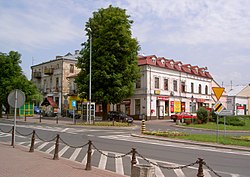Hrubieszów
Hrubieszów | |
|---|---|
 Town center | |
| Country | |
| Voivodeship | Lublin |
| County | Hrubieszów County |
| Gmina | Hrubieszów (urban gmina) |
| Government | |
| • Mayor | Tadeusz Garaj |
| Area | |
| • Total | 33.03 km2 (12.75 sq mi) |
| Elevation | 200 m (700 ft) |
| Population (2006) | |
| • Total | 18,617 |
| • Density | 560/km2 (1,500/sq mi) |
| Time zone | UTC+1 (CET) |
| • Summer (DST) | UTC+2 (CEST) |
| Postal code | 22-500 |
| Car plates | LHR |
| Website | http://www.miasto.hrubieszow.pl |
Hrubieszów [xruˈbʲɛʂuf] (Ukrainian: Грубешів Hrubeshiv) is a town in southeastern Poland, with a population of 18,661 (2004). It is the capital of Hrubieszów County. Since 1999 Hrubieszów has been part of Lublin Voivodeship (Polish: województwo lubelskie). Earlier, 1975–98, it had been part of Zamość Province (województwo zamojskie). Prior to 1919, it was part of the Russian Empire.
History
The town was founded in 1400 by Poland's King Władysław Jagiełło. He returned there in 1411, 1413 and 1430. A castle and church were later added. Kazimierz Jagiellończyk built a road from Lublin to Lviv passing by Hrubieszów. The town was eventually destroyed by Ukrainians and Tatars.
In 1800 Stanisław Staszic founded the Hrubieszów Agricultural Society, the first cooperative organization in Europe.
During World War II, the region witnessed the Zamość Uprising. Many inhabitants, including the 7,000 residents of the town's Jewish ghetto, perished in the war. Despite that more than half the population of the city was Jewish, there is no longer a Jewish population as a result of actions against the Jewish community.
The town is also notable for being the site of the largest joint action between the partisans of the Polish Freedom and Independence anti-communist movement and those of the Ukrainian Insurgent Army. In the summer of 1941, Julek (Joel/Jakób) Brandt, a Betar leader from Chorzów who was a relative of the chairman of the Hrubieszów Judenrad Samuel Brandt, arranged for several hundred members of the Betar youth movement in the Warsaw Ghetto to work on local farms and estates, including one in Dłużniów and Werbkowice. Before the war the estate in Dłużniów had belonged to Maks Glazermann, a Jewish engineer from Lwów who was left to run the property. Among those sent to Dłużniów was a young woman from Warsaw named Hanka Tauber. Her account of what went on there was recorded in the ghetto diary of Abraham Lewin.
Most of the Betar youth were killed in the spring of 1942 and in subsequent months together with the local Jewish population. A small number, however, managed to return to the ghetto and later took part in the Warsaw Ghetto uprising. Julek Brandt escaped from a transport heading for the death camp at Sobibor. He was denounced by local peasants who tuned hom over to the Gestapo in Hrubieszów. There he was put to work by Gestapo Obersturmbannführer Ebner who named him chief of a small work camp on Jatkowa Street. At the end of 1942 or the beginning of 1943, Ebner killed him.[1]
Notable People
Notable residents of Hrubieszow have included:
- Yosef Almogi, member of the Israeli Knesset
- Bolesław Leśmian, poet
- Henry Orenstein, poker-player, author, and entrepreneur
- Bolesław Prus, novelist
- Milton Rokeach, psychologist
Others with ancestry from the city include:
- David Mamet, American playwright
- Zalman Shazar, third President of Israel
Monuments

Hrubieszów boasts a number of monuments:
- An outdoor sculpture of Bolesław Prus.
- Orthodox church with 13 cupolas (1875).
- Saint Nicholas Catholic Church (17th-century).
- Madonna of Ceaseless Help Catholic Church (1903-5).
- Du Chateau manor complex, housing a regional museum.
- Madonna of Sokal Catholic Church.
- Jewish cemeteries (Old and New)
External links
- Official website of Hrubieszów
- Hrubieszów information service
- Hrubieszów Jewish genealogy site
- Official Hrubieszów County website

50°49′N 23°53′E / 50.817°N 23.883°E
- ^ Dariusz Libionka and Laurence Weinbaum - A New Look at the Betar 'Idyll' in Hrubieszów - Yad Vashem Studies XXXVII 1 (2009)



